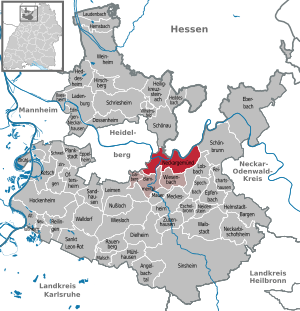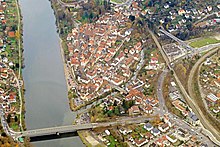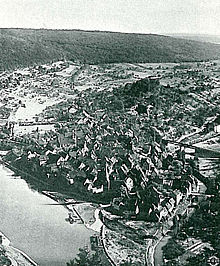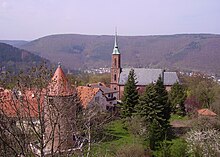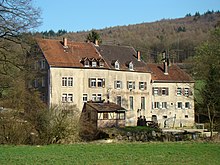Neckargemünd
| coat of arms | Germany map | |
|---|---|---|

|
Coordinates: 49 ° 24 ' N , 8 ° 48' E |
|
| Basic data | ||
| State : | Baden-Württemberg | |
| Administrative region : | Karlsruhe | |
| County : | Rhein-Neckar district | |
| Height : | 127 m above sea level NHN | |
| Area : | 26.15 km 2 | |
| Residents: | 13,290 (Dec. 31, 2018) | |
| Population density : | 508 inhabitants per km 2 | |
| Postal code : | 69151 | |
| Area code : | 06223 | |
| License plate : | HD | |
| Community key : | 08 2 26 056 | |
| LOCODE : | DE NMD | |
| City structure: | 4 districts | |
City administration address : |
Bahnhofstrasse 54 69151 Neckargemünd |
|
| Website : | ||
| Mayor : | Frank Volk (Free Voters) | |
| Location of the city of Neckargemünd in the Rhein-Neckar district | ||
Neckargemünd ( ) is a town on the Neckar , ten kilometers upstream east of Heidelberg in the Rhein-Neckar district in Baden-Württemberg . It belongs to the European metropolitan region of Rhine-Neckar (until May 20, 2003 the Lower Neckar region and until December 31, 2005 the Rhine-Neckar-Odenwald region ).
In the high and late Middle Ages Neckargemünd was an independent imperial city in the Holy Roman Empire , which is reflected in the city arms.
geography
Location and natural space
The city belongs to the Rhine-Neckar metropolitan region and is located at the eponymous confluence of the Elsenz in the Neckar , at the foot of the Hollmuth, surrounded by the foothills of the southwestern Odenwald . The district extends at a height of 116 to 469 meters. 19.1 percent of the 2615 hectare district are settlement and traffic areas, 28 percent are used for agriculture and 48 percent are forested. The municipality is part of the Neckartal-Odenwald nature park . The Elsenzaue, the area Sotten, a grubbing island east of Mückenloch, and the area Felsenberg are under conservation .
Neighboring communities
The city borders on Heidelberg in the west, on Schönau in the north, on Neckarsteinach in the north-east and on Schönbrunn and Lobbach in the east . Wiesenbach (Baden) lies south of Neckargemünd , and Bammental in the south-west .
City structure
The former communities of Dilsberg , Mückenloch , Neckargemünd and Waldhilsbach belong to the city of Neckargemünd . The hamlets of Dilsbergerhof, Neuhof and Rainbach belong to the former Dilsberg mountain fortress. The Neckarhäuserhof settlement belongs to Mückenloch . The city of Neckargemünd within the boundaries of 1972 ("core city") includes the city district of Kleingemünd , the Kümmelbacher Hof estate and the houses of the barrel factory, war mill and fulling mill. The former municipality of Waldhilsbach is now the district of Neckargemünd. In the area of the former municipality of Dilsberg, the village of Reitberg, which was abandoned in the Middle Ages, was located. The village of Ziegelhütte has risen in Neckargemünd.
history

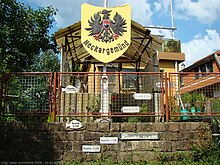
Until the 19th century
First mentioned in a document in 988 under the name of Gmundi , King Heinrich (VII) elevated the settlement to a free imperial city around 1230 . Emperor Ludwig pledged Neckargemünd in 1330 to the Count Palatine near Rhine , who in 1346 relocated the court of the Meckesheimer Centers here. In 1395 Neckargemünd lost the status of an imperial city when it was incorporated into the Palatinate territory. In 1466 the town received market rights , which were expanded in 1544. In 1566 the city and the entire Palatinate became Protestant.
In the following centuries the city was repeatedly occupied by foreign troops. During the Thirty Years' War it was the army of the Catholic League under Tilly in 1622 . In the Palatinate War of Succession , the city was occupied by French troops under General Mélac , in 1799 there were French revolutionary troops and from 1814 to 1819 the city was occupied by the Russian military . Finally, in 1849 , Prussian associations were here.
In 1803 Neckargemünd came to Baden and became the seat of a district office instead of the Dilsberg office . In Neckargemünd there was also a grand ducal district court of Baden . Neckargemünd lost all former imperial privileges as a result of the Baden municipal code in 1831. In 1857 the Neckargemünd district office was dissolved and the city was assigned to the Eberbach district and, from 1863, Heidelberg . With the opening of the Badische Odenwaldbahn in 1862 and the Neckar Valley Railway in 1879, the city was connected to the rail network.
20th century
In 1914 a tram connection to Heidelberg was created.
Politically, the National Liberals were the strongest before the First World War , while socialist and liberal parties were on par during the Weimar Republic . In 1933 the NSDAP , which had been the strongest party since September 1930, received just under 49 percent of the vote.
In contrast to Heidelberg, Neckargemünd was bombed during World War II. The main destination was the railway tracks along which the tunnel at the German House was located. In autumn 1944, for example, a direct hit destroyed the German House , the local NSDAP headquarters, which had set up a collection point for the winter relief organization here. The residents had fled into the vaulted cellar of this house, although it was not an official air raid shelter - it was at the Adler inn. But the vaults proved to be very stable, so that many people stayed alive there. In 1938 a large road bridge was inaugurated over the Neckar. On March 29, 1945 ( Maundy Thursday ), it was blown up , like most other crossings over the river, by pioneers of the German Wehrmacht . However, two days later, American troops took the city.
In 1967 the foundation stone was laid for the rehabilitation center for children and adolescents. When the district of Heidelberg was dissolved in 1973, Neckargemünd became the new Rhein-Neckar district . The population increased in the post-war decades through the admission of displaced persons , the designation of new building areas and incorporations. Politically, the CDU became the dominant party after 1945 .
Population development
Neckargemünd with Kleingemünd
| year | 1439 | 1577 | 1688 | 1727 | 1818 | 1852 | 1905 | 1939 | 1965 |
|---|---|---|---|---|---|---|---|---|---|
| Residents | 295 | 855 | 550 | 877 | 1956 | 2702 | 2637 | 3862 | 8107 |
Neckargemünd as it is today
| year | 1961 | 1970 | 1991 | 1995 | 2005 | 2010 | 2015 |
|---|---|---|---|---|---|---|---|
| Residents | 10.120 | 11,763 | 14,562 | 14,559 | 14,280 | 13,905 | 13,369 |
Incorporations
- Kleingemünd (January 1, 1907) - after becoming self-employed in the years from 1860 to 1906
- Dilsberg (January 1, 1973) - a small town with a historical center and medieval castle ruins
- Waldhilsbach (January 1, 1974)
- Mückenloch (January 1, 1975)
Religions
After the Reformation , the majority of today's districts were Protestant for a long time. Only on the Dilsberg did the garrison create a Catholic majority from 1700 onwards. After the Second World War, the number of Catholics increased due to the inclusion of displaced persons in the communities. In 2004, 40.6 percent of the population were Protestant and 32 percent Catholic.
politics
Municipal council
The municipal council usually has 22 seats. In addition, the mayor is the chairman with voting rights. By choosing the wrong part of town , the districts are guaranteed representation in the municipal council: the core town has 14, Dilsberg 4, and Mückenloch and Waldhilsbach each hold 2 seats.
In the local elections on May 26, 2019 , there were also 5 compensation seats, so that the local council will have 27 members until the next election in 2024. Overall, the election led to the following result (in brackets: difference to 2014):
| City council election 2019 | ||
|---|---|---|
| Political party | be right | Seats |
| Free voters | 27.4% (−1.6) | 7 (± 0) |
| GREEN | 26.4% (+6.5) | 7 (+2) |
| CDU | 21.2% (−5.1) | 6 (± 0) |
| SPD | 20.6% (−4.3) | 6 (± 0) |
| LEFT | 4.4% (+4.4) | 1 (+1) |
| Turnout 69.2% (+11.6) | ||
mayor
On June 26, 2016, Frank Volk prevailed in the runoff election by just under 134 votes against the incumbent Horst Althoff, who had previously been in office for 16 years.
| Mayor of Neckargemünd | ||
|---|---|---|
| Surname | Political party | Term of office |
| Mathäus Heckman | 1833-1839 | |
| Georg Reibold | 1839-1839 | |
| Adam Herpel | 1839-1842 | |
| Philipp Bauer | 1842-1848 | |
| Peter Pabst | 1848-1849 | |
| Franz Degen | 1849-1851 | |
| Adam Herpel | 1852–1855 (2nd term) |
|
| Georg Reibold | 1855–1861 (2nd term) |
|
| Julius Friedrich Menzer | 1862-1867 | |
| Carl Heckmann | 1867-1873 | |
| Carl Thilo | 1873-1899 | |
| Carl Wittmann | 1899-1902 | |
| Franz Heeg | 1903-1909 | |
| Wilhelm Steinbrunn | 1909-1910 | |
| Georg Schneider | 1910-1917 | |
| Carl Kirchmayer | 1917-1919 | |
| Dr. Emil Leist | 1919-1928 | |
| Georg Müßig | 1928-1939 | |
| Wilhelm Cloos | 1939–1942 (as first member of the association ) |
|
| Gottfried Kramer | 1942–1945 ( first deputy , then mayor ) |
|
| Georg Lampertsdörfer | 1945-1948 | |
| Heinrich Held | 1948–1966 (1948–1951 provisional) |
|
| Kurt Schieck | 1966-1984 | |
| Oskar Schuster | 1984-2000 | |
| Horst Althoff | CDU | 2000-2016 |
| Frank Volk | Free voters | since 2016 |
coat of arms
The blazon of the coat of arms reads: In gold, a red armored and red-tongued black eagle, covered with a silver breast shield, in which a blue orb with a gold cross and gold fittings.
A seal from 1359 already showed the imperial eagle typical of an imperial city. The coat of arms in its current form can be seen for the first time in 1645 in Merian's Topographia Palatinatus Rheni . The flag is black and yellow.
Town twinning
City partnerships exist with
- Évian-les-Bains in France since 1970
- Missoula in Montana in the United States since 1993
- Jindřichův Hradec in the Czech Republic since 1996
- Romeno in Italy since 1992 (partner community of the Waldhilsbach district)
A sponsorship was taken over for Valeč in the Czech Republic in 1965 .
Culture and sights
Neckargemünd is located on the Burgenstraße , the Neckar Valley Cycle Path and the Neckarsteig , all of which lead past many sights.
Buildings
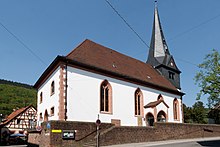
In the old town of Neckargemünd, which stretches up the slope from the Neckar valley, you will find a wide variety of sights. In addition to the previous main thoroughfares, Hauptstrasse and Neckarstrasse, which each run through the old town in only one direction, there are numerous small alleys with many half-timbered houses . Particularly noteworthy is the very narrow Kleppergasse, which runs directly on the back of the former city wall . The previously disruptive through traffic in the old town was largely reduced by the road tunnel opened in 2011, which runs roughly parallel to the railway tunnel, and by subsequent traffic calming measures.
On the banks of the Neckar is the Protestant St. Ulrich Church , which was built on the foundation walls of a building in the 12th / 13th centuries. The predecessor church built in the 19th century was built in the late Gothic style. The Catholic parish church of St. Johannes Nepomuk can be found on the higher market square. The current building in neo-Romanesque style was built on the site of a smaller Catholic church in 1894/96. Nearby is also the former Lutheran church, which was built in 1770/71 in the classical style. Sold to the city in 1821 as a result of the Baden church union between Reformed and Lutherans in the same year, it was used as the town hall until 1984 ; now the museum for various aspects of the city's history is housed there.
Villa Menzer is located in the Menzerpark at the beginning of Dilsberger Straße. It was built in 1892 by the architect Leonard Schäfer . The villa and the beautifully landscaped park surrounding it have long been Neckargemünd's outstanding attractions. It was the home of Julius Menzer (1846–1917), owner of a wine wholesaler who was the first to introduce Greek wines to Germany; later he was appointed Greek consul and a member of the Reichstag for the German Conservative Party . The Villa Menzer with its current appearance is the result of the reconstruction after a severe fire in 1947, which completely destroyed the old, multi-part roof structure. Between June 2003 and June 2008, the municipal high school in Menzerpark was housed in containers after a school fire . A little further down on Neckarstrasse is the Greek wine tavern "Zur Stadt Athen" , which Menzer opened in 1882 and which has been closed since the end of 2012 . During his time as a member of the Reichstag, Menzer also opened a Greek wine bar in Berlin, which was followed by another in Frankfurt. But both branches were unsuccessful and soon had to close again.
Next to the wine bar and in the heart of the old town stood the Hotel Ritter (formerly Hotel Pfalz ), a former hunting lodge from 1286. It fell victim to a fire in the night of January 10, 2003. No investor was found for the reconstruction of this historic building, whereupon the city decided in July 2006 to demolish the ruin. A modern residential complex with condominiums was built on the site of the hotel, with individual old building elements (including an archway) being integrated into the new building.
Next to it is the Prince Carl, a former inn with a brewery from the 16th to 18th centuries. Today its rooms are used by the music school and the Eberbach - Neckargemünd adult education center.
At the end of the old town and at the beginning of the Wiesenbachertal is the Karlstor , which was built in 1788 in honor of the Elector Karl Theodor . This is also indicated by a Latin inscription above the archway.
Only the foundation walls of Reichenstein Castle can be seen on Neckargemünder's local mountain Hollmuth, which was abandoned at the end of the 14th century and has since fallen into disrepair.
youth
The Altes E-Werk youth club has existed in Dilsberger Strasse since 1990, and is directed by the Stadtjugendring Neckargemünd and appeals to children and young people as well as adults with various cultural offers and events.
Museums
The museum in the old town hall opened in 1988. It has its roots in the city history collection (1935–39) and the Neckargemünd local history museum (1938–87). It depicts the history of Neckargemünd and, in addition to a folklore and an art history section, has a focus on Neckar shipping. In addition, special exhibitions are held regularly showing the works of Neckargemünd artists.
music
The pop group Liquido , which was particularly successful with the song "Narcotic" from 1999, comes from Neckargemünd.
The oldest and largest choral society in Neckargemünd is the
- GV Liederkranz 1857 Neckargemünd eV
Sports
- Gymnastics Club 1876 Neckargemünd
- Gymnastics Club 1907 Kleingemünd
- SpVgg 1911 Neckargemünd looks back on a hundred-year tradition as a football club . Since 1996 there has been another football club, FC Blau Weiss Neckargemünd 96.
- Athletics community
Economy and Infrastructure
traffic
The station Neckargemuend is by lines S1, S2, S5 and S51 of the S-Bahn RheinNeckar half hour to Neckartal web and neckargemünd-bad friedrichshall-jagstfeld railway towards Eberbach / Mosbach / Sinsheim and Heidelberg / Mannheim operated. The second stop in the city, Neckargemünd-Altstadt , is only served by the S-Bahn lines S1 and S2.
Neckargemünd is integrated into the RNV bus network. Bus route 35 runs every 20 minutes between Heidelberg and the terminus at the education center in Spitzerfeld. Neckargemünd is connected to smaller towns in the Neckar Valley and the Odenwald via other bus lines and call taxes within the framework of the VRN. Neckargemünd belongs to the tariff area of the Rhein-Neckar transport association .
The federal highways 37 ( Kaiserslautern - Neckarelz ) and 45 ( Sinsheim - Wöllstadt ) run through the town . The federal motorways 5 and 656 can be reached via Heidelberg, and the federal motorway 6 can be reached via the Elsenz Valley (B 45) .
From 1914 to 1962 Neckargemünd could also be reached by tram , the “Neckartalbahn” of the Heidelberg tram led from here via Heidelberg city center to Wieblingen.
Public facilities
The city is (together with Eberbach ) the seat of the church district Neckargemünd-Eberbach of the Evangelical Church in Baden . The district forest office of the Rhein-Neckar district is located in the former Elly-Heuss-Knapp-Schule.
Neckargemünd operates a terrace open-air swimming pool with a diving pool, a 50-meter lane (Olympic pool), a non-swimmer pool with a slide and a baby paddling pool in the Neckar Valley. The Olympic pool and the diving pool have been a natural pool since the 2008 bathing season.
education
In Neckargemünd there are three state primary schools (Dilsberg / Mückenloch, Waldhilsbach, Neckargemünd) and a special educational and advisory center with a special focus on learning (Erich-Kästner-Schule) (the former Hauptschule with Werkrealschule is now in Bammental ), as well as a school center with Realschule and grammar school as well as a state school with boarding for the hearing and speech impaired.
The school center burned down almost completely on June 2, 2003. After two years of tough negotiations, during which the lessons were outsourced to temporary containers, a modern school center equipped for full-day operation was built on the same site by 2008. The new building, built in passive house construction, was awarded the PROM of the year by RWE Energy AG in 2009 for the most energy-efficient commercial or public property.
In addition, the operating SRH in a large educational center with boarding the Berufsbildungswerk Neckargemünd and two state-approved private schools : The Stephen-Hawking-Schule (SHS), a UNESCO project school is on the formation of physically disabled children and young people with special needs in inclusive education not geared towards disabled students. The school covers the Baden-Württemberg school system in ten elementary courses from primary level to grammar school. The Leonardo da Vinci Gymnasium is a school for gifted children and young people.
There is also a music school and an adult education center in Neckargemünd. The city runs a library. For the youngest residents there are three communal, three private and two Evangelical and two Roman Catholic kindergartens.
Personalities
Honorary citizen
- 1893: Ludwig Carl Reichert, Catholic parish priest
- 1895: Gustav Wöttlin, Dean, Protestant town pastor
- 1984: Kurt Schieck, Mayor from 1966 to 1984
- 1992: Henri Buet, former mayor of the twin town Evian
- 1994: Wolf-Peter Haasemann, long-time city councilor and 1st deputy. mayor
- 2000: Oskar Schuster, mayor from 1984 to 2000
sons and daughters of the town
- Philipp Pfeiffer (1784-1859), senior bailiff in Baden
- Johann Philipp Bronner (1792–1864), pharmacist and viticulture pioneer
- Friedrich von Saporta (1794-1853), Bavarian major general
- Johann Friedrich Wundt (1822–1889), businessman and member of the Baden state parliament
- Heinrich Lang (1824–1893), architect
- Ludwig Gaddum (1843–1910), lawyer and administrative officer
- Julius Menzer (1845–1917), wine wholesaler, Greek consul and member of the Reichstag for the German Conservative Party
- Carl Beck (1856-1911), medic
- Johanna Richter (1871–1943), politician ( DNVP ), member of the Baden state parliament
- Hermann Knorr (1897–1976), politician ( SPD ), member of the state parliament and co-founder, co-editor and editor-in-chief of the Rhein-Neckar-Zeitung
- Rainer Ohlhauser (* 1941), born in Dilsberg, national soccer player
- Ronald Mönch (* 1942), constitutional lawyer
Other personalities associated with the city
- Hugo Wolf (1830–1900), revolutionary in 1849
- Viktor Lenel (1838–1917), founder of the former children's rest home (Viktor Lenel Stift)
- Richard Lenel (1869–1950), President and Honorary President of the Mannheim Chamber of Commerce and Industry
- Georg Hermann (1871–1943), writer, lived here mainly from 1917 to 1933
- Ernst Marfels (1886–1958), portrait and landscape painter, living here since 1920; Son of the watch dealer and collector Carl Marfels (1854–1929)
- Karl Jäger (1888–1959), SS functionary and war criminal, lived after the end of the war as unencumbered denazified in nearby Wiesenbach and then on the Kümmelbacher Hof until his arrest .
- Udo Adelsberger (1904–1992), co-developer of the quartz watch , spent his old age here
- Hans Vogt (1911–1992) , the composer lived in Neckargemünd from 1949 to 1992
- Gernot Müller (* 1941), Germanist and literary scholar
- Michail Krausnick (1943–2019), writer
- Gudrun Reinboth (* 1943), writer
- Angelika Zahrnt (* 1944), environmentalist
- Hans G. Nutzinger (* 1945), economist
- Gunter Dueck (* 1951), mathematician
- Martina Pötschke-Langer (* 1951), head of the collaboration center for tobacco control
- Hansi Flick (* 1965), former co-national soccer coach
literature
- Richard Nutzinger: War Chronicle of the City of Neckargemünd . Typewritten manuscript, 29 pp. Neckargemünd, August 1945, reprinted in the Neckargemünder Jahrbuch 1995
- State Archive administration Baden-Württemberg in connection with d. Cities and districts Heidelberg u. Mannheim (Hrsg.): The city and districts Heidelberg and Mannheim: Official district description .
- Vol. 1: General part . Karlsruhe 1966
- Vol. 2: The city of Heidelberg and the municipalities of the district of Heidelberg . Karlsruhe 1968
- Günther Wüst: A thousand years Neckargemünd 988–1988. Contributions to the history of a Neckartal community. City of Neckargemünd 1988, ISBN 978-3-93103-300-2
- Hermann Eris Busse: Heidelberg and the Neckar Valley . In: Badische Heimat. Journal for folklore, heritage, nature and monument protection . 26th year 1939. p. 417, "Neckargemünd in the 16th and 17th centuries" . o. V., Freiburg im Breisgau 1939.
- Badische Heimat, publications of the regional association Badische Heimat. Journal for Folklore, Local History, Nature Conservation and Monument Protection Yearbook, Issue 4 Ekkhart 1975
- Neckargemünder Jahrbuch, publisher Stadt Neckargemünd, published from 1989 to 1998, articles on the city's past and present, editors: Wolf Peter Haasemann, Klaus Hoepke, Doris Meyer zu Schwabedissen, Uwe Uffelmann, Günther Wüst
- Slogsnat, Helmut: Neckargemünd. "A jewel in the Electoral Palatinate". Heidelberg - Ubstadt-Weiher - Basel: Verlag Regionalkultur, 2015, ISBN 978-3-89735-864-5
- von Solodkoff, Michael: Neckargemünd “a prelude from Heidelberg with a view of the world”. Heidelberg - Ubstadt-Weiher - Neustadt adW - Basel: Verlag Regionalkultur, 2016, ISBN 978-3-89735-911-6
- Odenwald, Rolf: Families in Neckargemünd and Kleingemünd 1640-1910 . Edited by the city of Neckargemünd. Verlag regionalkultur Ubstadt-Weiher - Heidelberg - Basel 2019, ISBN 978-3-95505-129-7
Individual evidence
- ↑ State Statistical Office Baden-Württemberg - Population by nationality and gender on December 31, 2018 (CSV file) ( help on this ).
- ↑ Statistisches Landesamt Baden-Württemberg, status: December 31, 2010 ( page no longer available , search in web archives ) Info: The link was automatically marked as defective. Please check the link according to the instructions and then remove this notice.
- ^ State Institute for Environment, Measurements and Nature Conservation Baden-Württemberg
- ^ The state of Baden-Württemberg. Official description by district and municipality. Volume V: Karlsruhe District Kohlhammer, Stuttgart 1976, ISBN 3-17-002542-2 . Pp. 381-384
- ↑ District description vol. 2 p. 741: Neckargemünd with Kleingemünd, without Dilsberg, Mückenloch and Waldhilsbach.
- ↑ District description vol. 2 p. 741: Neckargemünd with Kleingemünd, without Dilsberg, Mückenloch and Waldhilsbach.
- ^ Federal Statistical Office (ed.): Historical municipality directory for the Federal Republic of Germany. Name, border and key number changes in municipalities, counties and administrative districts from May 27, 1970 to December 31, 1982 . W. Kohlhammer, Stuttgart / Mainz 1983, ISBN 3-17-003263-1 , p. 475 .
- ↑ a b Federal Statistical Office (ed.): Historical municipality register for the Federal Republic of Germany. Name, border and key number changes in municipalities, counties and administrative districts from May 27, 1970 to December 31, 1982 . W. Kohlhammer, Stuttgart / Mainz 1983, ISBN 3-17-003263-1 , p. 487 .
- ↑ Neckargemünd Main Statute, Section 14 ; accessed May 31, 2019.
- ↑ Baden-Württemberg State Statistical Office: Municipal council elections 2019, City of Neckargemünd ; City of Neckargemünd: City Council Election 2019 (PDF) ; accessed May 31, 2019.
- ↑ http://www.rnz.de/nachrichten/region_artikel,-Mit-509-Prozent-wird-Frank-Volk-Neckargemuends-Buergermeister-_arid,202536.html#null
- ^ Herwig John, Gabriele Wüst: Wappenbuch Rhein-Neckar-Kreis . Ubstadt-Weiher 1996, ISBN 3-929366-27-4 , p. 86
- ^ Klaus Hoepke: One hundred years of Villa Menzer. In: Neckargemünder Jahrbuch 1992, pp. 6–29.
- ↑ Ursula Kohl: Museum Guide Rhein-Neckar-Kreis . Schwetzingen 1995, ISBN 3-87742-101-6
- ↑ Completed special exhibitions , Neckargemünd website, accessed on February 13, 2014
- ↑ The winners. (No longer available online.) PROM of the year, archived from the original on June 27, 2009 ; Retrieved July 9, 2009 . Info: The archive link was inserted automatically and has not yet been checked. Please check the original and archive link according to the instructions and then remove this notice.
- ↑ Georg Hermann and the house at Poststrasse 2 at www.stanomir.de (accessed on October 27, 2012)
Web links
- City of Neckargemünd
- LEO-BW, discover regional studies online , Neckargemünd
- Neckargemünd on a website about historical architecture

